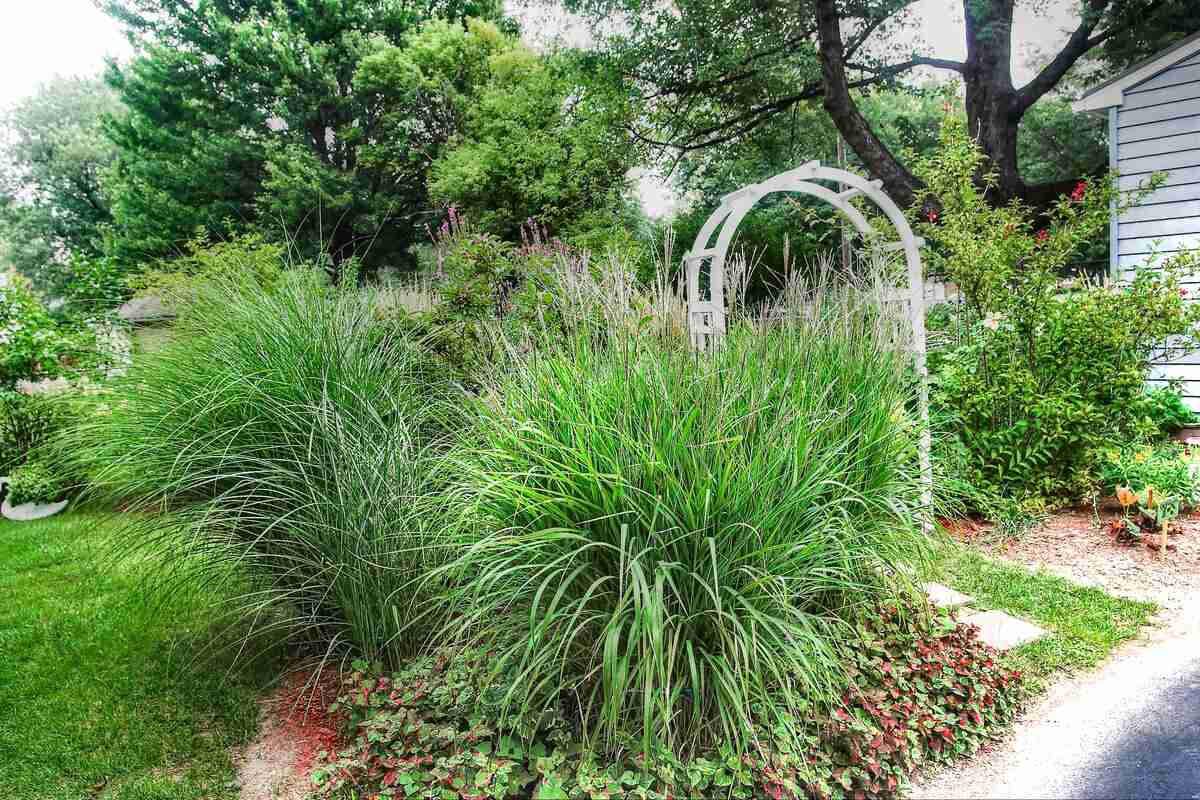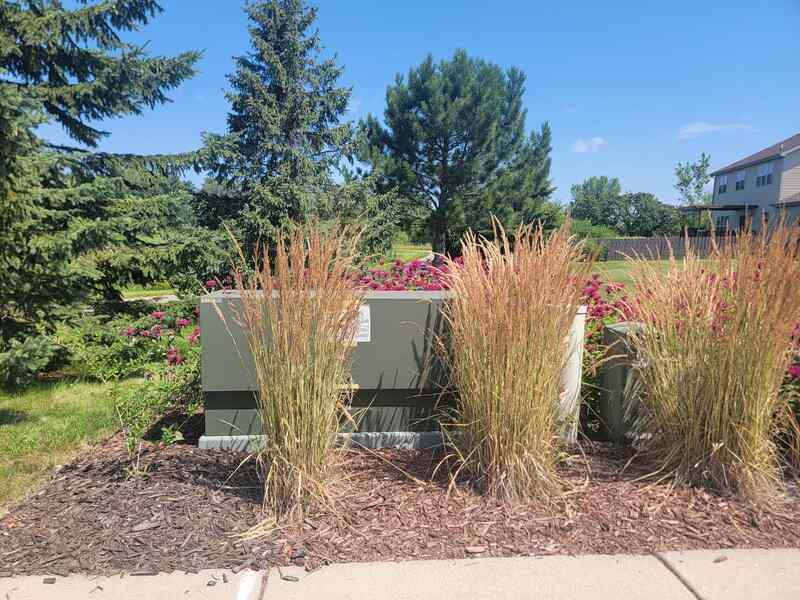
Ornamental grass care is easy as pie: Cut back dry stems in the spring, water and control weeds and pests during summer, and let the plants be in fall and winter.
Of course, there are exceptions, like invasive grasses, floppy bundles, and sensitive species. But even so, ornamental grasses are low maintenance and perfect for the beginner gardener. Learn from this guide how to care for ornamental grass with great results even if it’s your first try.
What we discuss in this ornamental grass care guide:
Key Takeaways:
- Native ornamental grasses are the closest to zero maintenance.
- Know your plant’s sunlight and moisture needs.
- Water newly planted grasses regularly during the first year.
- It’s better to apply less water and fertilizer than too much.
- Spring is the best time to cut back.
Seasonal Maintenance

| Spring Ornamental Grass Care | Summer Ornamental Grass Care | Fall & Winter Ornamental Grass Care |
| – Cut back the dead foliage – Divide overcrowded clumps – Clean up the base – Apply fertilizer IF necessary | – Water IF necessary – Monitor for pests and diseases – Remove weeds – Avoid trimming | – Leave the foliage intact (if you can) – Avoid heavy mulching- Reduce watering |
Note: No time for gardening? Hire a landscaping professional to take care of your ornamental grasses.
Spring Care
In my garden, spring care starts with thorough clean up, pruning and dividing mature plants. That’s also what your ornamental grasses need in the early season:
Cut back the dead foliage. It gives your grasses a tidy look, improves airflow, and lets more sunlight reach the crown and new shoots, speeding up growth by a few weeks.
- When to cut back ornamental grasses: Prune cool-season grasses in late winter to early spring. Warm-season grasses can be cut back from late fall to mid-spring, but spring is the best time.
- How far to cut back ornamental grasses: Cut warm-season grasses down to 3 to 6 inches and cool-season grasses down to 1/3 of their height.
- How to cut back ornamental grasses: Put on leather gloves and long sleeves to avoid grass cuts, bundle tall grasses (to keep the stems together), then cut with a hedge trimmer.
Divide overcrowded clumps. Divide mature grasses that are 3 to 4 years old — ideally before the grasses are overgrown and die back in the center. Old, dense grasses are harder to dig out.
- How to divide ornamental grasses: Cut the bundle 6-8 inches above the soil. Dig the roots with a shovel or a spade and pull out the clump. Divide into smaller plants.
- Replant as soon as possible or share with neighbors and friends.
Clean up the base. Remove fallen leaves, twigs, and debris inside and around the grass bundles. All that dead material can attract pests and diseases.
Apply fertilizer once a year (only if necessary). Most ornamental grasses don’t require fertilizer, but, as with watering, there are some exceptions when a light application can help:
- Grasses that grow on poor, sandy soil.
- Ornamental grasses grown in containers.
- Newly planted grasses.
Use organic fertilizers such as rotted manure, mushroom compost, leaf mold, or a balanced (e.g., 10-10-10) synthetic slow-release formula.
| Don’t overfertilize ornamental grasses. It leads to tall, weak plants, more vulnerable to diseases and unable to stand on their own. |
Summer Care

Unlike turfgrass and vegetables, ornamental grasses need little care during summer. Just keep an eye out for pests and diseases, and water if there’s a prolonged dry spell.
Water if necessary. Most ornamental grasses are drought-tolerant, making them top plant choices for xeriscaping and rock gardens. Once established (after the first year), they can thrive on natural rainfall alone with some exceptions:
- New grasses: Water every other day during the first week after planting and twice a week for the rest of the growing season.
- Most cool-season grasses during summer: Water every 3 weeks if it’s a dry, hot summer to prevent the plants from entering dormancy and turning brown.
- Water-loving grasses, sedges, and rushes during dry periods (e.g. moor grass, wood rush, hook sedge).
| Water deeply and infrequently to promote deep roots and improve drought tolerance. Avoid overhead watering, and irrigate the base of the plant instead to prevent diseases — drip irrigation is an excellent choice. |
Apply mulch to improve drought-tolerance. A light layer of mulch moderates soil temperature and keeps moisture in.
- Useful for moisture-loving species like the morning star sedge, creeping red fescue, and wood-oats.
- Don’t mulch right to the plant’s crown. It can lead to root rot and fungal diseases, especially in small types of ornamental grasses like little bluestem.
Note: The grass crown is the plant’s growing point from which all stems and roots develop.
Monitor for pests and diseases. Ornamental grasses are more resilient than turf, but some pests and diseases can still damage them, such as:
- Root-munching pests like gophers, voles, and rabbits. Ornamental grasses are deer-resistant plants.
- Aphids, armyworms, lace bugs, mealybugs, and spider mites.
- Fungal diseases such as leaf spot, powdery mildew, root rot, and leaf rust. Crowded, shaded, and overwatered grasses have a higher risk of infestation.
Remove weeds. Grassy weeds growing inside the bundle can turn into a real headache. If they spread among the plant’s stems and leaves, you’ll need to dig out the plant and divide it to eliminate them. Also remove weeds around the plant to improve air circulation and reduce competition.
| Young ornamental grasses can resemble grassy weeds. Check multiple times before pulling them out. |
Avoid trimming your ornamental grasses during summer. The bundle will look bad the entire season, and it can also disrupt the plant’s growing cycle:
- The additional stress can lead cool-season grasses into dormancy.
- Warm-season grasses invest energy in regrowth and might not have time to prepare for the cold-season.
Fall and Winter Care
Leave the foliage intact until spring pruning. The stems and leaves protect the crown from freezing temperatures and dry winds. They also add color and texture to your winter landscape.
Exceptions:
- Wildfire-prone areas: Cut back warm-season grasses as soon as they dry out. Dry material can easily spread a fire.
- Wet winters: Heavy snow can weigh down softer grasses, making spring care more difficult.
- You really want a neat winter yard.
Reduce watering: Temperatures are dropping, so water doesn’t evaporate as fast. Reduce watering or stop it all together.
Avoid heavy mulching: A thick layer of mulch can easily lead to root rot once the temperatures drop, and water evaporates slower.
| Light mulching helps protect the roots from freezing in areas with dry, freezing winters. Apply a thin layer, 2 to 3 inches thick, after the first frost. |
Special Maintenance Considerations

How to care for ornamental grasses in pots:
- Water regularly, when the top few inches of the soil dry out. Reduce watering during winter.
- Apply fertilizer once a year, in the spring.
- Bring the container inside during winter if the plant is not hardy in your zone.
Caring for specific varieties:
- Maiden grass: Limit fertilizer. Excessive feeding reduces the grass’s ability to withstand winter cold and winds.
- Mexican feather grass: Don’t overwater. Its wiry blades might flop.
- Blue oat grass: Water regularly during dry spells to keep its deep blue-green color from fading.
- Pampas grass: Avoid nitrogen applications. Excess can prevent the plant from blooming.
- Indian grass: One of our best native ornamental grasses, Indian grass might require staking since some varieties have softer, less stiff stems when mature.
Common Maintenance Problems
| Problem | Causes & Solutions | |
| Flopping or sprawling | Overfertilization → Stop fertilizing Insufficient sunlight → Trim trees. Move to a sunnier spot. Support the bundle with stakes. | |
| Center die-out | Dense, overgrown foliage → Repair (dig out the center root mass and fill the hole with garden soil) or dig out the plant and divide it. | |
| Invasive spreading | Runners or heavy seeders in a favorable environment → Pull out new seedlings. Cut the flower heads before seeding. | |
| Browning tips | Winter-desiccation → Cut back in the spring Underwatering → Water during dry spells Overwatering → Reduce or stop irrigation Excess nitrogen → Irrigate to dilute the fertilizer Insects on the grass → Wash the plant with the garden hose Fungal disease → Divide the plant to improve air flow. Treat with fungicide. | |
FAQ
Yes, evergreen ornamental grasses don’t need to be cut back yearly. They require only a light trimming that includes clipping the dry flower stalks and finger-combing dead stems and blades.
The best way to clean up after cutting back ornamental grasses is to bundle the grass before cutting. This way, you carry the cuttings by the rope to the waste bin or compost pile and only need to rake a few leftover debris.
Give Your Ornamental Grasses Professional Care
Keep your ornamental grasses in the best shape possible with professional care. Find a landscaping expert with LawnStarter, relax, and enjoy their vibrant colors and gentle sway year-round.
Sources:
- “Considerations for Selection and Use of Ornamental Grasses.” By Mack Thetford, associate professor, Department of Environmental Horticulture, UF/IFAS West Florida Research and Education Center; and Mary Salinas, residential horticulture agent, UF/IFAS Extension Santa Rosa County. University of Florida.
- “Ornamental Grass Care.” UCCE Master Gardeners, Fresno County. University of California.
- “Ornamental Grasses.” By David H. Trinklein, adjunct associate professor and state extension specialist in Floriculture. University of Missouri Extension.
- “The Color Encyclopedia of Ornamental Grasses: Sedges, Rushes, Restios, Cat-tails, and Selected Bamboos.” By Rick Darke. Timber Press, Inc., 1999.
Main Image Credit: gardener41 / Flickr / CC BY-SA 2.0